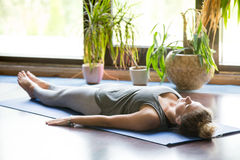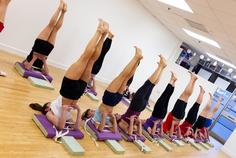What Yoga Class is Right for You? Decoding 10 Styles of Yoga Jargon
As a yoga teacher, one of the most common questions I encounter is ‘which type of yoga should I choose?’. If it’s your first yoga class or you’re looking to develop a regular practice and you want to dip your toe in the proverbial yoga pool, it can be extremely helpful to decode some yoga jargon, whether it be in English or Sanskrit.
Hatha
All active yoga styles fit under the umbrella of ‘Hatha Yoga’. Hatha literally means force, or effort, and refers to any yoga where effort and movement in the form poses are occurring. If you are consciously moving and exerting effort, you are performing hatha yoga. As a beginning class, I would highly recommend checking out a class labelled hatha or gentle hatha. You can expect poses for all levels, a slower pace, and modifications for new yogis.

Restorative
Another great style to check out as a first class, if you have an injury, or are looking to relax and settle your frayed central nervous system is restorative. Restorative yoga is exactly as you would imagine. It is comprised of sitting and prone poses, and utilizes lots of props such as bolsters and blankets for support and relaxation.
Yin
Yin yoga appears to be the same as restorative in that it’s a slow pace with sitting and prone poses, however, poses are held significantly longer to target deep connective tissue in the body and maintain flexibility. Both restorative and yin yoga are considered passive, meditative forms of yoga, and are deeply beneficial for stress relief and creating balance.
Yoga Nidra
Yoga Nidra is yogic sleep. Yes, that’s right. A yoga class where you can go and have guided, enriched, nap time. The sounds of nature or Tibetan bells combine with the teachers’ voice to wash away all physical and mental stress and achieve complete physical and psychological relaxation. It is purported that 20-30 minutes of Yoga Nidra is the equivalent of 4 hours of conventional sleep; it can reduce symptoms of PTSD, anxiety, and insomnia. I would highly recommend checking out a class if you have any level of yoga practice; no meditation experience is necessary. I would only suggest doing an evening class relatively close to home when you don’t have to engage too much, can draw a bath, and relax for the rest of the night, simultaneously giving yourself a pat on the back for making it to your mat!

Hot Yoga
On the other end of the spectrum are all hot yoga classes, which are held in a heated room, somewhat intense, and very sweaty. In the west, hot yoga is hugely popular as a workout, and as such branding of hot yoga has run rampant. You will find hot yoga chains such as Oxygen Yoga, YHot, Powerfow Yoga, ad infinitum. Any yoga in a heated room is hot yoga, and it’s a great cleansing workout, allowing you to get deeper into poses as your muscles and facia are heated.
Bikram
Bikram Yoga is a wildly successful hot yoga brand created by Bikram Chodhury 30 years ago. It’s a set and trademarked series of 26 poses that is charged, energetic, and guaranteed to make you sweat. Bikram is quite controversial as a result of several lawsuits, but being so popular, it’s a really easy style to find!
Ashtanga
Ashtanga is also a set series of poses, though the poses are different than Bikram, the room isn’t heated, and Ashtanga has its roots in ancient Indian teachings. Despite room temperature, Ashtanga is still a physically demanding style that also links movement with breath. I would recommend Ashtanga after a few classes of Hatha, but one great advantage is that once the sequence and poses are learned, it’s very easy to transfer to a regular home practice.
Iyengar
Iyengar Yoga, developed by B.K.S Iyengar, is a slow, alignment-based practice which utilizes props to help students achieve optimal alignment. Classes will be comprised of around 6 poses which take time to set up and are held for a longer period. Despite the slow pace, Iyengar Yoga is quite challenging, and over time you will be amazed at the poses you can do! Iyengar teacher trainings are extensive, and as such not every studio offers classes. However, if you are working with an injury or looking for extra support for challenging poses, this style is certainly worth checking out.

Vinyasa
Vinyasa is another word for flow yoga, it’s a fluid and somewhat challenging sequence of poses. Personally, I think it’s a beautiful practise linking movement with breath, allowing for stress release, an increase in subtle energy flow in the body, and a great way to build confidence and strength. Though it is practised at room temperature, Vinyasa will build heat in the physical body and feel like a workout. I would recommend trying a class after a few Hatha or hot yoga classes or taking a private class to become comfortable with some common pose sequences.
Anasura
Anasura is a newcomer to the North American yoga scene and was developed by John Friend in 1997. The wonderful aspect of Anasura yoga is that it’s entirely based on the belief we are all filled with intrinsic goodness or Shri in Sanskrit. Anasura uses the physical body and asana to allow students to open their hearts and access the natural grace and beauty that inherently resides in every one of us. Class sequences can vary from teacher to teacher, but they are based on Friends’ Universal Principles of Alignment, developed to allow the body to operate optimally. Anasura classes are a great experience, and principles can be applied throughout any yoga discipline.
Whatever your goals or experience may be, the growing popularity of yoga in the west has created an incredible spectrum of classes. If finances are an obstacle, many studios offer a karma class once a week, where the class is free or by donation. Many community centres also offer classes at a reduced rate. If you’re still terrified to enter a studio class or not sure what to expect, book a private class in the comfort of your own home. This will allow you to learn poses and alignment principles on a deeper level and boost your confidence; it is incredibly empowering.
Please, never let fear, confusion, yoga jargon, or the misconception that yoga is for certain body type or demographic dissuade you. I know for years, fear, anxiety, and lack of confidence kept me from my mat and on the sidelines of the yoga community. We are all on this journey together and are all deserving of the gifts of this amazing practice. In the words of Brene Brown, “Sometimes the bravest and most courageous thing you can do is just show up”.